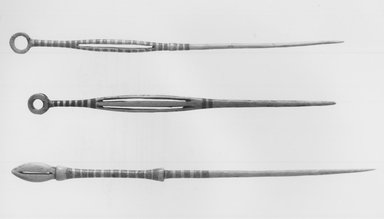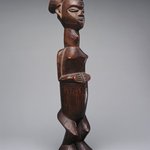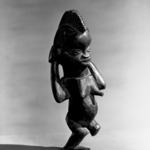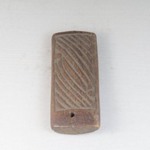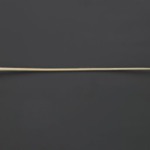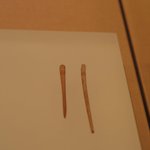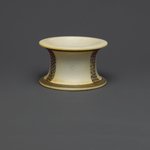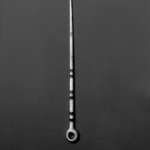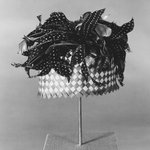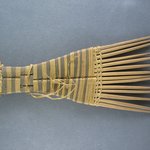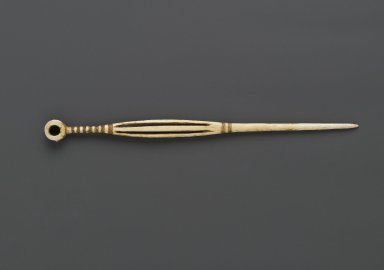

Mangbetu. Hairpin, late 19th or early 20th century. Ivory, 7 1/16 x 3/8 in. (18 x 1 cm). Brooklyn Museum, Museum Expedition 1922, Robert B. Woodward Memorial Fund, 22.1605. Creative Commons-BY (Photo: Brooklyn Museum, 22.1605_PS6.jpg)

Mangbetu. Hairpin, late 19th or early 20th century. Ivory, 7 1/16 x 3/8 in. (18 x 1 cm). Brooklyn Museum, Museum Expedition 1922, Robert B. Woodward Memorial Fund, 22.1605. Creative Commons-BY (Photo: Brooklyn Museum, 22.1605_bw.jpg)
Hairpin
Arts of Africa
Ivory’s value results from its scarcity, as well as its association with the elephant, a symbol of power and strength. Ivory bracelets, decorated with engraved designs, were made by the Fur of the Darfur region of Sudan and traded as far as Eritrea and the Republic of the Congo. Hairpins from the northeastern Democratic Republic of the Congo are worn by both men and women to hold hats and ornate hairstyles in place. These hairpins are particularly ostentatious, since each is made from a large piece of ivory, most of which is carved away.
MEDIUM
Ivory
DATES
late 19th or early 20th century
DIMENSIONS
7 1/16 x 3/8 in. (18 x 1 cm) (show scale)



COLLECTIONS
Arts of Africa
ACCESSION NUMBER
22.1605
CREDIT LINE
Museum Expedition 1922, Robert B. Woodward Memorial Fund
CATALOGUE DESCRIPTION
One end of the hairpin has a flat open ring; the other comes to a point. Through the central area of the shaft are two lengthwise openings. From under the ring of the hairpin to a short distance below the lengthwise openings in the shaft, are nine incised crosshatched bands filled with pigment for decoration.
Condition: Good; end of ring has chips.
EXHIBITIONS
MUSEUM LOCATION
This item is not on view
CAPTION
Mangbetu. Hairpin, late 19th or early 20th century. Ivory, 7 1/16 x 3/8 in. (18 x 1 cm). Brooklyn Museum, Museum Expedition 1922, Robert B. Woodward Memorial Fund, 22.1605. Creative Commons-BY (Photo: Brooklyn Museum, 22.1605_PS6.jpg)
IMAGE
overall, 22.1605_PS6.jpg. Brooklyn Museum photograph, 2011
"CUR" at the beginning of an image file name means that the image was created by a curatorial staff member. These study images may be digital point-and-shoot photographs, when we don\'t yet have high-quality studio photography, or they may be scans of older negatives, slides, or photographic prints, providing historical documentation of the object.
RIGHTS STATEMENT
Creative Commons-BY
You may download and use Brooklyn Museum images of this three-dimensional work in accordance with a Creative Commons license. Fair use, as understood under the United States Copyright Act, may also apply.
Please include caption information from this page and credit the Brooklyn Museum. If you need a high resolution file, please fill out our online application form (charges apply).
For further information about copyright, we recommend resources at the United States Library of Congress, Cornell University, Copyright and Cultural Institutions: Guidelines for U.S. Libraries, Archives, and Museums, and Copyright Watch.
For more information about the Museum's rights project, including how rights types are assigned, please see our blog posts on copyright.
If you have any information regarding this work and rights to it, please contact copyright@brooklynmuseum.org.
RECORD COMPLETENESS
Not every record you will find here is complete. More information is available for some works than for others, and some entries have been updated more recently. Records are frequently reviewed and revised, and we welcome any additional information you might have.
